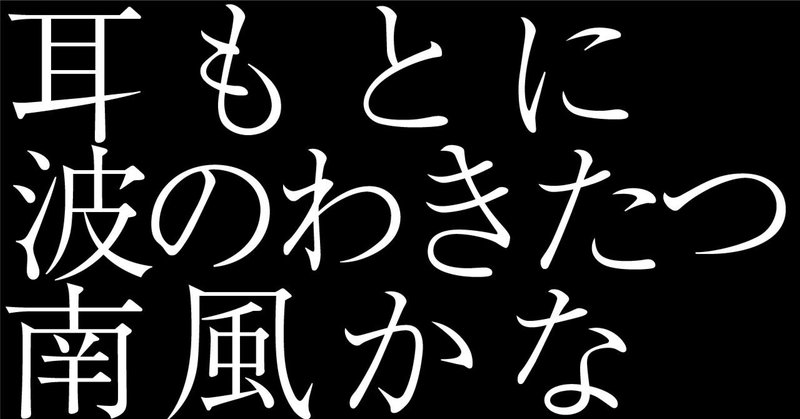
#320 AIが俳句を解釈したらこうなった。 「耳もとに波のわきたつ南風かな」久保田万太郎
耳もとに波のわきたつ南風かな
久保田万太郎
"Right by my ear, waves surge and rise—the south wind."
Kubota Mantaro

解説:
この俳句は久保田万太郎によるもので、次のように解釈できます。
「耳もとに波のわきたつ南風かな」
風物詩
南風: 南から吹く風、特に初夏から夏にかけての季節風です。温かく心地よい風で、夏の訪れを感じさせます。
波: 海の波の音が聞こえることから、海岸近くの風景を想像させます。この時期の海の景色や音は、特に心に残るものです。
表現手法
擬人法: 「耳もとに波のわきたつ」という表現で、波の音がまるで人のささやきのように感じられるという擬人法が使われています。
体言止め: 句の終わりに「南風かな」として、余韻を持たせることで感情の余韻を読者に伝えています。
情緒や感情や情感や情念
情緒: 初夏の南風が心地よく感じられ、波の音が耳に届くことで、リラックスした気持ちや自然への親近感が生まれます。この時期の海辺の風景と音は、特に感傷的で心地よいものとして受け取られます。
感情: 南風と波の音が耳元で感じられることで、詩人は平和で穏やかな感情を抱いています。日常の喧騒から解放され、自然の中でリラックスしている様子が伝わります。
情感: 自然の風と波の音が、詩人の心に深い印象を与えています。初夏の風景の美しさや心地よさが、感覚的に強く感じられます。
情念: この俳句には、自然との一体感や季節の移ろいに対する深い感動が込められています。南風と波の音が、詩人の内面に静かな喜びと感動を呼び起こします。
この俳句は、初夏の訪れを象徴する風物詩であり、その時期の心地よい風景と感覚を見事に描写しています。自然の美しさと静かな感動が、読者に深い共感を呼び起こす作品です。
英訳:
Explanation
This haiku, composed by Mantaro Kubota, can be interpreted as follows:
"Right by my ear, waves surge and rise—the south wind."
Seasonal Imagery
South Wind: A wind blowing from the south, particularly associated with the early summer to summer season. It's a warm and pleasant wind that signifies the arrival of summer.
Waves: The sound of waves indicates a coastal scene, evoking images of the seaside during this season. The sound of the waves during this time is particularly memorable.
Poetic Techniques
Personification: The phrase "right by my ear, waves surge and rise" personifies the sound of the waves, making it seem as if they are whispering near the poet's ear.
Ending with a Noun (Taigendome): The poem ends with "the south wind," leaving a lingering impression and conveying the emotional resonance to the reader.
Emotions and Sentiments
Atmosphere: The gentle south wind and the sound of waves create a serene and comforting atmosphere. This seasonal coastal scene is particularly sentimental and soothing.
Feelings: The poet feels a sense of peace and tranquility as the south wind and the sound of the waves reach his ear. It suggests a moment of relaxation and a connection with nature, away from the hustle and bustle of daily life.
Sentiments: The natural elements deeply impress the poet's heart. The beauty and comfort of the early summer landscape evoke strong sensory and emotional responses.
Passion: The haiku expresses a profound appreciation and emotional response to nature and the changing seasons. The south wind and the sound of waves stir quiet joy and deep emotion within the poet.
This haiku serves as a poetic representation of early summer, beautifully capturing the seasonal landscape and sensations. The natural beauty and quiet emotions evoke deep empathy in the reader, making it a deeply resonant piece.
久保田万太郎

久保田万太郎(1889年11月7日 - 1963年5月6日)は、東京出身の小説家、劇作家、俳人で、俳号を「暮雨」や「傘雨」としました。彼は東京の下町を舞台に市井の人々の生活と情緒を描く作品で知られています (Wikipedia) (Aozora Online)。
経歴と業績
久保田は、慶應義塾大学在学中に小説「朝顔」や戯曲「遊戯」を発表し、早くから文才を認められました。その後、俳句や演劇にも進出し、多くの戯曲や俳句を残しました。彼の代表作には、小説「末枯うらがれ」「寂しければ」「春泥」、戯曲「大寺学校」、句集「流寓抄」などがあります (Wikipedia)。
俳句の特徴と代表作
久保田の俳句は、身近な風景や日常の一コマを情緒豊かに表現することが特徴です。代表的な俳句には以下のようなものがあります:
「春浅し 空また月を そだてそめ」:春の浅い空に新月が満月に向かって育つ様子を詠んだ句 (俳句の教科書)。
「神田川 祭の中を ながれけり」:夏の祭りの中をゆっくり流れる神田川を描いた句 (俳句の教科書)。
「扇風機 止めれば雨の 音のまた」:扇風機を止めると再び聞こえてくる雨音を表現した句 (俳句の教科書)。
晩年と影響
久保田は戦後も活発に創作を続け、日本芸術院会員や文化勲章受章者となりました。彼の作品は今でも多くの人々に読まれ続けており、その豊かな表現力と人間味あふれる作風は高く評価されています (Wikipedia) (Aozora Online)。
彼の詳細な作品リストや俳句の解説については、青空文庫や俳句の教科書サイトで確認することができます。
五月十八日
(英訳:ChatGPT 解説:Bing / ChatGPT 画像生成:midjourney)
この記事が気に入ったらサポートをしてみませんか?
